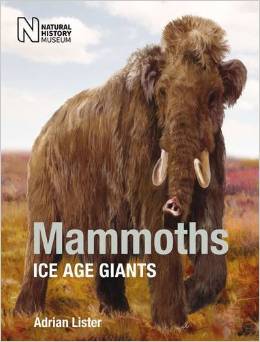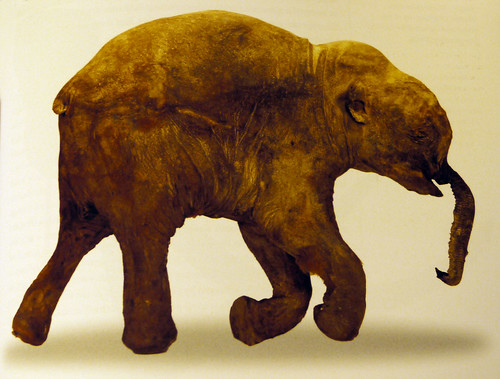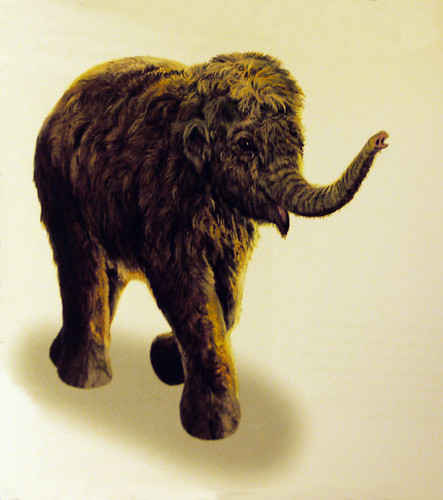Enormous, elephantine and extinct the mammoth is the iconic animal of the Ice Age. These colossal creatures roamed the cold, open landscapes of Europe, Asia and North America as recently as 20,000 years ago. Today, their well-preserved fossil remains generate much fascination and speculation around the world. Mammoths: Ice age Giants reveals what their life was really like. It describes their environment, behaviour, evolution and appearance, including new DNA analysis that shows what colour mammoths actually were. Unravelling the latest scientific research, Adrian Lister explains why this incredible species died out and whether it may be possible to clone them in the future. He also draws challenging parallels between the fate of the mammoths and that of their close relatives, the living elephants.
Throughout the book there are striking photographs of skeletons, skulls, tusks and preserved flesh from the world-famous collections of the Natural History Museum in London, as well as images of the best preserved mammoth in the world, Lyuba. From the Pleistocene period to our recent past, Mammoths: Ice Age Giants captures evolution in action in the dynamic world of the mammoth.
Review:
This book was published by the Natural History Museum to co-inside with their exhibition of the same name. The lavishly illustrated book is divided into five chapters; Mammoths and elephants, Tusks and trunks, The world of the Ice Age, Frozen and living and Endangered and extinct.
The book compliments the exhibition well, but there is no need to have seen the exhibition to enjoy the book. Adrian presents the evolution of the mammoth, their environment and suggests why it may have become extinct. The book is very readable with up to date information. Well worth a read if you are interested in this subject.
The Exhibition:
One of the main reasons for my recent visit to London was to see the ‘Mammoths: Ice Age Giants’ exhibition at the Natural History Museum in order to see baby Lyuba, the most complete woolly mammoth ever found. Whilst there I was surprised to learn that there are three types of elephant not just two because there are two types of African elephant; plains and forest.
This exhibition opens with a replica of a mammoth skeleton in bedrock and an actual thigh bone just to give a context of their scale. From here, the show never lets up on this sense of scale with mammoth skulls, tusks and hair samples adding to the wonder of a towering full-scale model of a Columbian mammoth, alongside other giants of the time including a short faced bear and a sabre toothed cat.
The display is littered with interesting facts such as the elephant family tree showing us that mammoths aren’t actually direct descendants or ancestors of elephants — they both diverged from an earlier common ancestor. It also tackles questions such as how close we are to being able to clone a mammoth, and the ongoing conservation efforts to preserve modern day elephants.
The highlight is of course Lyuba — a baby mammoth who was found in Northern Russia in 2007. She is remarkably well preserved and it’s a great opportunity to see the detail of the skin and hair up close.
The exhibition (now coming to a close) was very well done and well worth a visit. The two mammoth pictures are photographs I have taken of illustrations in the book.











The ice age was quite interesting. The area I live in was crave my a ice dam breaking.
Coffee is on
The rise and fall of ice ages is certainly fascinating.
Talk about educational!
You would have loved the exhibition
I recall a heated discussion with some deep greens some years back when I lived in the Huon Valley Tasmania). The greenies were warming the climate with their heated assertions, one of which was that the natural state of the valley was a forest. Indeed it had been a forest as recently as when the Europeans first arrived here. I
It was at a ‘public hearing’ for some scheme of other (possibly the siting of a fish processing plant) and the long-haired ones were shouting about ‘5000 years ago it was pristine forest’ instead of today’s wicked, evil farmland. I put my oar in, asking the chap who seemed to be the ‘leader’ just why he had picked on that period and not the one before when the valley had 600 ft high ice in it.
It got a momentary laugh at least.
I would love to have been a fly on the wall when you said that
When campaigning for or against anything it always pays to do your research and have valid facts and arguments. They clearly didn’t!
I would have loved to see the poppies in real, what a labour of love. The earplugs, cracked me up… one has to be used to wearing earplugs otherwise it is a nuisance.
Great pictures again and I bet you love your bike.
We all have times when we are to busy to visit each others blogs.
You and Ginnie should hop over to England to see the poppies, you would love them. The exhibit will finally be finished on 11th November and the following day they will start picking the poppies ready to be dispatched to those who have bought one.
I am enjoying my bicycle, although I haven’t had chance to ride it as much as I would like.
The ice face is really fascinating,
It seems that it is a real great exhibition.
Thanks for dropping by and leaving a comment
It was a really interesting exhibition.
Fascinating but not so sure I’d like to have been living back then.
Less home comforts but probably the same political problems
Poor baby elephant.
I watched Ice Age 4 just a couple of days ago. He he…
Yes poor little thing she fell into a ditch and inhaled mud causing her to suffocate.